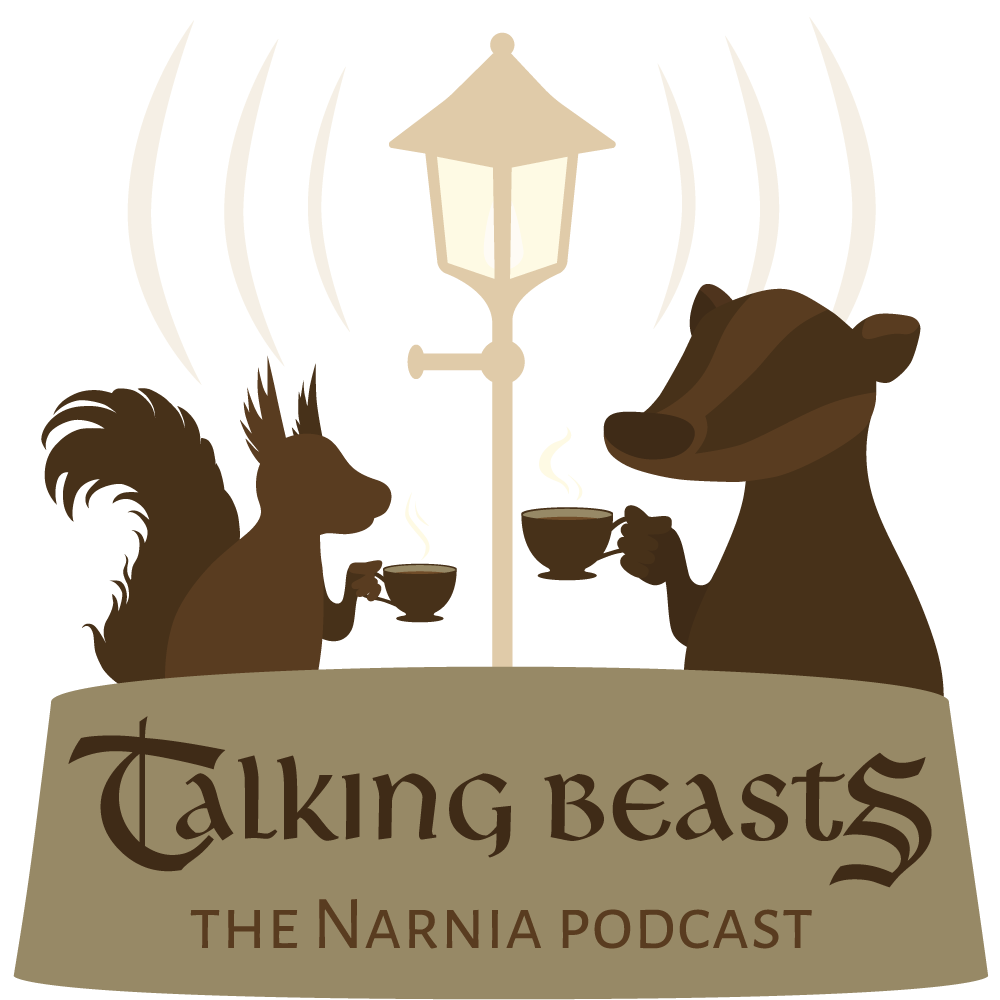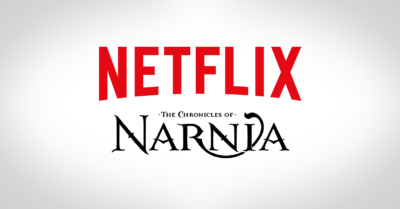New Interviews at Family Christian Stores Event
Yesterday morning, Family Christian Stores held events for local church leaders. Attendees received some free promo materials, and watched a DVD. It began with Dr. Michael Stevens discussing the story and important themes in the Prince Caspian book.
VIDEO: “STORYTELLING IN PRINCE CASPIAN”
Towards the end, they showed an exclusive video which included interviews with some of the cast and crew. It began with an introduction by Douglas Gresham from the Telmarine courtyard set:
Douglas Gresham:[C.S. Lewis’] story of Prince Caspian has inspired generations of readers around the world with its themes of courage, loyalty, faith, perseverance, compassion, and forgiveness wrapped in an epic tale of adventure. Through stories, C.S. Lewis strove to exalt his readers with the most sublime qualities of our shared humanity. With Prince Caspian as a starting point, let’s explore the way that stories, with their extraordinary ability to speak to the heart, can ennoble and enrich our souls.
There were a few new behind the scenes shots. One showed the Pevensies running into the water and jumping for joy with their shoes off. A few others showed them entering the Stone Table room, and looking at the carvings. Remember the shot in LWW where the camera backs up to reveal the cracked Stone Table? I think they’re going to have a very similar kind of shot to reveal it in Prince Caspian.
Georgie Henley: The good thing about stories is that they carry you to another place which you’ve never been. It gives you a secure environment and you feel like you’re just enveloped by the book and the characters and everything that is happening. … Narnia is almost our complete imagination; we can interpret however we like. C.S. Lewis says that Aslan is big but he doesn’t describe him a lot. So for people who like dark gold lions it can be dark gold, if you like white lions it can be a white lion, and he’s completely different in everybody’s imagination. That’s the beauty of all the Narnia books.
Mark Johnson: C.S. Lewis did such a wonderful job setting up the world of Narnia and the characters either within Narnia, or the characters from war-torn England and taking them into Narnia. And what he’s done, unlike a lot of writers who are very specific from what he/she is wearing to what he/she is thinking, Lewis allows you to complete it…. The beauty of all the Narnian Chronicles is that, it’s like Shakespeare: The stuff of great stories are embedded in these seven books with wonderful morals and adventures and character decisions and character tests that have to be achieved along the way. … Story-telling may be our most original and romantic impulse. That is, to be told a story or to tell a story. You look at the cave drawings [in the Prince Caspian book/film], and they’re all about telling stories and depicting something.
Dean Wright: It’s a struggle of good against evil. It’s a story of these kids who are put into a world where they have to make a difference or really bad things can happen. And as a moviegoer, you can watch that and identify with that.
DOUGLAS GRESHAM INTERVIEW
Next up was a video of Dr. Michael Stevens interviewing Douglas Gresham:
Q: I know that Jack maintained that his Chronicles of Narnia were not meant to be allegorical. Do you think people make to much of what Jack is trying to say in these books?
DG: To start with, I think you have to realize that in the days that Jack was writing and speaking, the word ‘allegory’ meant something very different from what it means today. Allegory today is anything that might possibly symbolize or be similar to anything else. This is a corruption of the original meaning of the word. If “The Lion, the Witch and the Wardrobe” was to be an allegory of Jesus Christ for example, you would have to have the lion born into the lowest race of the creatures of that world, in terms of a carpenter’s son. He would have to live and minister for thirty years, then tortured to death and resurrected on the third day and so on and so forth for it to be an allegory. They are not allegorical works in the strictest sense of the word. And yes, people do go out of their way to try to find all kinds of hidden meanings. We seem to be a species that loves conspiracy theories: “There has to be a hidden meaning, there has to be a hidden structure.” A very nice man and a friend of mine, Michael Ward, has recently written and published a book all about how Narnian Chronicles are all based on the seven planets of the medieval astronomical system. I like Michael enormously, but I think his book is nonsense.
Q: I know Jack was a classical scholar and it seems to me he was very interested in the parallels of virtues and vice. Is there a way you seem him, throughout the Chronicles, elaborating on virtues and vices and using that as a thematic element?
DG: To some extent, but only to some small extent. I think Jack realized quite early in his vice is in fact virtue corrupted. The devil cannot create, he can only corrupt things that God has created. And therefore, all of the vice we look at around our world today is in fact great things that God created that the devil has corrupted. I think that’s what you see in Narnia. You see the forces of evil corrupting great things. Cair Paravel was a beautiful castle; Miraz’ castle is a dark nasty place. If you take any of the true philosophies of man and corrupt them, you get evil. So it is simply a matter of comparing virtue and vice by realizing that vice is virtue corrupted.
Q: Do you think there’s a way in which you can read Prince Caspian as a test case for the three Christian virtues of faith, hope, and love being worked out in characters’ lives. And do you think faith, hope, and love play a central thematic role throughout the Chronicles?
DG: Yes, I think you can because in “Prince Caspian,” we see what happens to the Telmarine people as a result of doing away with all the great things like faith, hope, and love and so forth. You wind up with a dictatorship under a cruel and merciless king, a murderer. You wind up with a dark, depressing, dreary world in which there is no joy. And when you return to the faith, which the Narnians were born to and made for, it all comes back to being what it should be. There is joy, there is happiness, there is rejoicing, there is freedom. All of these things are part of the return to faith after the many years of corruption.
Q: So are there ways that Narnia is like our world, and the lives led in Narnia are like our lives here and now?
DG: Narnia is not like our world, quite deliberately, until evil gets into it. And we bring it there. In “The Magician’s Nephew,” it was Digory Kirke who brought the White Witch to Narnia. It was a pure beautiful country until Digory brought evil to it. It is very interesting, Jack’s concept in the science fiction trilogy and the Narnian Chronicles. At the time that Jack was writing these books, science fiction writers were writing they still do today, writing stories about going off into space and finding some aliens who are always evil and out to kill us and so forth. Jack turned that on its head. We go out into space to another place and we are the evil monsters, and they are the pure creatures that we should be leaving alone. I think that’s something we really need to pay attention to. In his book “Out of the Silent Planet,” this is the silent planet because we are the fallen species; we are the bad guys. And we need to learn if we ever do go out into space and meet a new alien species, chances are 50/50 that we will be the bad guys.
UPDATE: Here is a copy of the handout given at the event.
Family Christian Stores
The Chronicles of Narnia: Prince Caspian
A Ministry Tool
The Virtues in Prince Caspian
March 29, 2008
Faith
The journey of Peter, Susan, Edmund and Lucy shows examples of their struggles with faith in Aslan’s presence, the consistency of Narnian customs and in a vision rather than their own rationality.
.Lucy responds well to Aslan’s call.
.Edmund bounces back from The Lion, the Witch and the Wardrobe and acquits himself well.
.Peter really struggles to believe beyond what he can empirically know and actually see.
.Susan shows herself lazy with her faith, knowing what is right but just not doing it.
It is not a surprise that this turns out to be Peter and Susan’s last journey to Narnia. They are losing the capacity for child-like faith like that discussed in Matthew 18:3-4.
Hope
Prince Caspian’s journey in the story is an example of hope:
.Caspian’s worldview was formed by his nurse, who filled his mind with tales of Old Narnia. Yet all the lore and the stories of the ‘Great Lion,’ the talking beasts, and the magical kings of yore had been suppressed by the alternate history taught by the Telmarines.
.Caspian has a choice: he can hope in the truth of the old stories, where his heart leads him, or he can stay in the safety-net of the Telmarine history.
Caspian’s hope is forged in the crucible of affliction much as is outlined in Romans 5:3-5. In the end, he does indeed show himself to be a worthy king.
Love
It is Aslan who is always the chief practitioner of love in Narnia. As in The Magician’s Nephew, he is the creator who, as we saw in The Lion, the Witch and the Wardrobe, sacrificed himself to offer redemption.
.The second half of Prince Caspian is a split narrative, as Aslan allows the battle, while he travels the countryside showing his love by releasing nature from the bondage imposed by the Telmarine oppression.
.By the time Aslan reaches the battlefield, he has restored creational goodness to Narnia, and even extends his love to the Telmarines by giving them the option to return to their homeland.
Aslan’s love not only resonates with the Creation narrative of Genesis 1-2, but also with the account in Romans 8 of all creation groaning in bondage to sin and longing for redemption.
Courage
The courage of Reepicheep the Mouse, on splendorous display, results in deeds which match his valorous words.
.Yet Reepicheep’s fortitude is not without scrutiny from Aslan, who chides him by saying, “I have sometimes wondered, friend, whether you do not think too much about your honor.”
.Aslan teaches a crucial lesson about virtue: too little of a good quality is certainly destructive but too much zeal, even though in pursuit of a high end, may also become a sort of vice.
.Though Aslan eventually fully restores Reepicheep, we are left to remember that virtues cannot act in isolation – courage must have self-control, zeal must have knowledge.
Similarly, we see that the fruits of the Spirit outlined in Galatians 6:22¬26, along with other sets of spiritual virtues like those outlined in II Peter 1 or in I Timothy 3, are not cafeteria lines where we pick out the ones we like or find easy. Rather virtues are meant to be built and exercised in concert with one another.
Endurance
Truffiehunter the Badger exhibits the virtue of endurance, which might also be called diligence, single-mindedness, or faithfulness:
.We hear Trufflehunter proclaim several times “I’m a beast and we don’t change. I’m a badger, what’s more, and we hold on.”
.This trait might be construed as simple stubbornness, but it leads to proper action in this story, Trufflehunter’s tenacity is honored because it is set in the right direction, in belief of the old stories that give life.
Truffiehunter’s mix of tenacity and kindness is a living-out of the thoughts expressed in Romans 12:9-13 and in I Timothy 4:15-16, passages which charge readers to hold tightly to the right stories.
The event will be held again on April 22.





